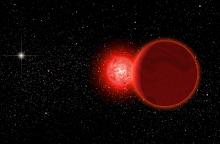Listen to today's episode of StarDate on the web the same day it airs in high-quality streaming audio without any extra ads or announcements. Choose a $8 one-month pass, or listen every day for a year for just $30.
You are here
Mars, Venus, Moon
The three big astronomical objects that pass closest to Earth appear close to each other in the western sky early this evening: the Moon and the planets Venus and Mars. Venus is the “evening star,” to the left of the crescent Moon. Mars is only about one-half of one percent as bright as Venus. But it’s just a skosh to the left of its brilliant sibling, making it fairly easy to pick out. The trio is quite low in the sky as darkness falls, so the viewing window is short.
The Moon is always the closest major object to Earth. It averages less than a quarter of a million miles away. The only bodies that get closer to us are small asteroids. But no asteroid gets closer on a regular basis.
Venus is next on the list. At its closest, it cozies about 25 million miles from Earth. It’s not that close now, though. It’s on the opposite side of the Sun, so it’s about 133 million miles away. But it’s getting closer. It’s looping toward us, and will be closest in about six months, when it passes between Earth and the Sun.
Mars can get as close as about 36 million miles. It’s about six times that distance now, and moving farther. It’ll be farthest in early October, when it will line up behind the Sun. After that, it’ll start moving closer again. The Red Planet will be closest in December of next year, so it’ll put on a good show in late fall and into the winter.
Script by Damond Benningfield





